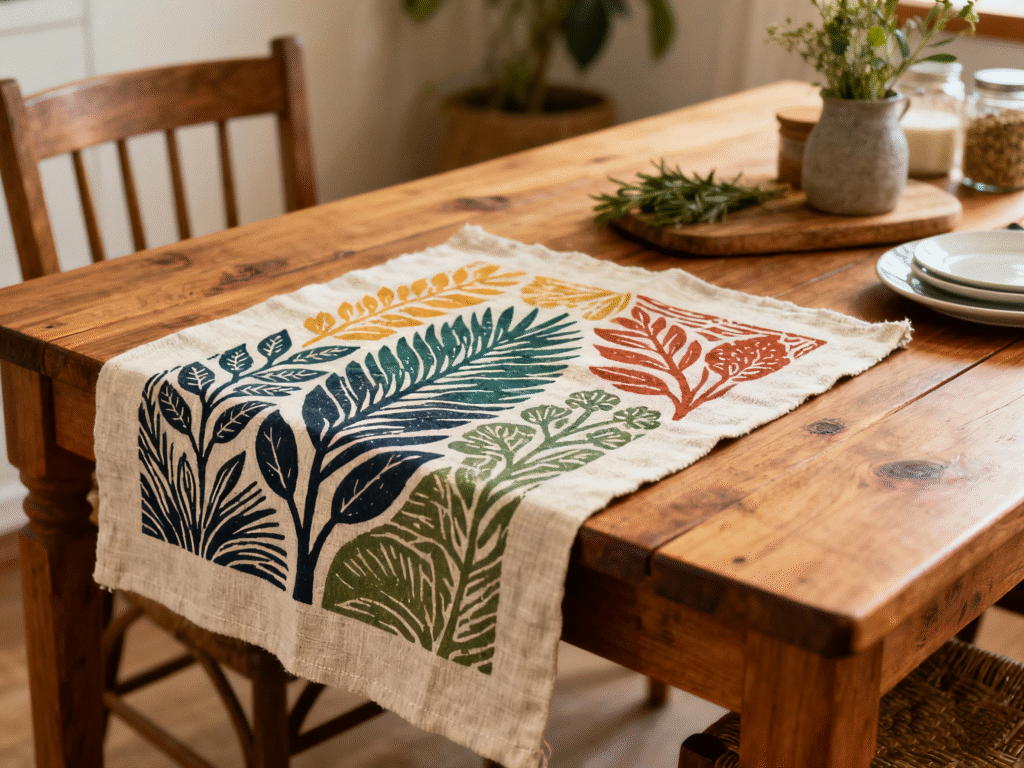
In our guide, How to Use Linen Tea Towels, you’ll see that if you think tea towels are just for drying dishes, you’re missing out on half their magic. ✨ These humble linens have been woven into daily life for centuries, carrying with them both utility and quiet elegance.
A brief look back shows linen’s deep roots in Europe, where it was prized not only for its luxurious texture but also for its remarkable durability. Archaeological finds even reveal linen textiles dating back thousands of years, and many households once passed down well-kept linen as heirlooms. Unlike cotton, linen fibers grow softer and more absorbent with use, which explains why your grandmother’s towels may still outshine a brand-new pack from the store.
But linen tea towels aren’t just about wiping hands or drying dishes. They double as décor pieces, can be repurposed into chic wrapping for gifts, and even serve as eco-friendly alternatives to paper products. Their versatility has made them a quiet design favorite in sustainable households, restaurants, and creative studios alike.
In this guide, we’ll uncover how linen tea towels go far beyond the sink:
- Practical uses you can try right away.
- Eco-friendly benefits that save money and reduce waste.
- DIY and styling ideas that add charm to everyday routines.
By the end, you’ll never look at a simple linen square the same way again. And with that, let’s dive into the next section:
👉 How to Use Linen Tea Towels — 25+ Smart, Real-World Ideas
How to Use Linen Tea Towels — 25+ Smart, Real-World Ideas
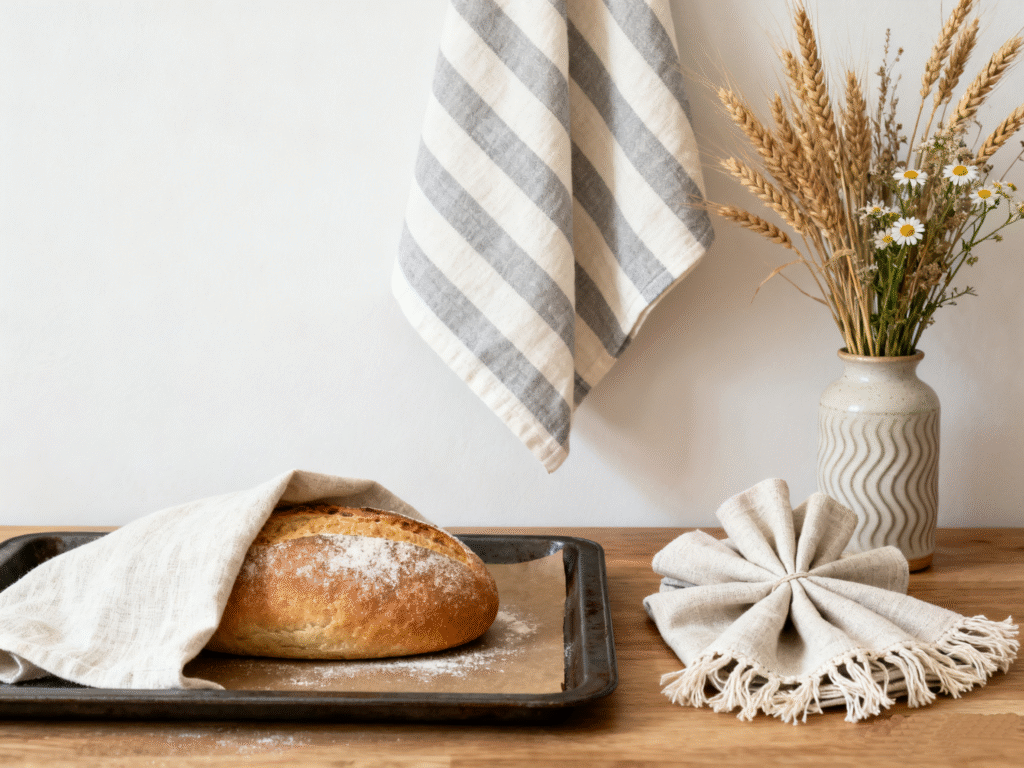
You’ve seen that linen tea towels are more than a kitchen accessory—they’re multitasking tools hiding in plain sight. Below, we’ll break down practical uses into mini how-tos, complete with gear lists, pro tips, and caution notes. Think of it as your field guide to turning a square of linen into the Swiss Army knife of your home.
Prep & Cooking
The “Nosrat Rice” Method
- Gear list: Linen towel, heavy pot lid, large pot of rice.
- How-to: Wrap a clean, dry linen towel around the underside of your pot lid before covering. The fabric absorbs excess steam, preventing soggy rice and yielding fluffier grains.
- Why linen works: High absorbency and heat resistance.
- Do/Don’t:
- ✅ Do tuck ends tightly so they don’t dangle near the flame.
- ❌ Don’t use damp towels—steam burns are no joke.
Proofing & Covering Dough
- Gear list: Linen towel, rice flour, dough, peel or tray.
- How-to: Lightly flour the towel and use it as a couche to cradle baguettes or boules during their final rise. Lift and shift loaves easily by holding the towel edges.
- Why linen works: The fibers wick moisture, keeping dough from sticking while allowing airflow.
- Do/Don’t:
- ✅ Do use rice flour (sticks less than wheat flour).
- ❌ Don’t wash proofing towels after every use—brush off excess flour and let them season.
Straining & Draining
- Gear list: Linen towel, bowl, strainer, dairy or coffee base.
- How-to: Line a sieve with a tea towel to strain yogurt into Greek yogurt, separate curds for ricotta, or filter cold-brew coffee.
- Why linen works: Tight weave is fine enough to catch solids but sturdy enough to reuse.
- Do/Don’t:
- ✅ Do wash immediately after dairy use.
- ❌ Don’t replace proper cheesecloth for delicate cheeses—you’ll want the finer mesh.
Produce Care
- Gear list: Linen towel, colander, leafy greens/herbs.
- How-to: Pat-dry washed greens, roll fresh herbs in a damp towel to extend shelf life, or line colanders to prevent bruising.
- Why linen works: Breathable fibers keep produce fresh without trapping excess water.
Steam & Slip Control
- Gear list: Linen towel, cutting board or mixing bowl.
- How-to: Place a folded towel under cutting boards or bowls to stabilize during chopping or whisking.
- Why linen works: The texture grips surfaces better than paper towels and doesn’t shred.
Baking & Breads
Basket Liners & Warmers
- Gear list: Linen towel, breadbasket, fresh rolls.
- How-to: Line baskets or wrap rolls to keep them warm at the table. The towel helps balance moisture: soft enough to prevent drying, but breathable enough to preserve crust.
Flouring & Couche Work
- Gear list: Linen towel, rice flour, baguette dough, peel.
- How-to: Dust a towel generously, shape baguettes on it, then flip onto the peel for baking.
- Case Study: Baguettes proofed on linen vs. bare sheet pans show a marked difference—linen-proofed loaves have more open crumb and sharper crusts.
Drinks, Serving & Styling
Polishing Glassware
- Gear list: Linen towel, wine or cocktail glasses.
- How-to: Dry glassware with a flat-weave towel to avoid streaks. Professional sommeliers often prefer linen for lint-free shine.
- Why linen works: Minimal fiber shedding compared to cotton or microfiber.
Table Service
- Gear list: Linen towel, dining table, plates.
- How-to: Use as napkins, placemats, or bread cloths. They also double as rustic menu backdrops for food photography.
Picnics & Gifting
- Gear list: Linen towel, bottle of wine, small gifts.
- How-to: Wrap a bottle in furoshiki style or line a gift basket with a towel—beautiful and reusable.
Cleaning & Everyday
Spill Triage
- Gear list: Linen towel, sponge cloth, paper towels.
- How-to: Reserve linen for absorbent but low-mess jobs (like mopping up coffee). Save paper for greasy spills and sponge cloths for scrubbing.
Appliance Buffing
- Gear list: Linen towel, spray bottle, stainless steel or glass appliances.
- How-to: Use dry linen to polish stainless or glass surfaces without streaks.
Shelf & Cabinet Liners
- Gear list: Linen towel, scissors (optional).
- How-to: Lay folded towels inside shelves or drawers for a washable, eco-friendly liner.
Each of these techniques shows how linen isn’t just charming—it’s a workhorse textile that can make your kitchen smarter, greener, and a little more beautiful. 🌿
And while versatility is its superpower, hygiene is the secret to making sure your towels stay safe to use. Let’s move on to the next crucial step:
👉 How to Keep Linen Tea Towels Hygienic — The Kitchen Safety Playbook
How to Keep Linen Tea Towels Hygienic — The Kitchen Safety Playbook
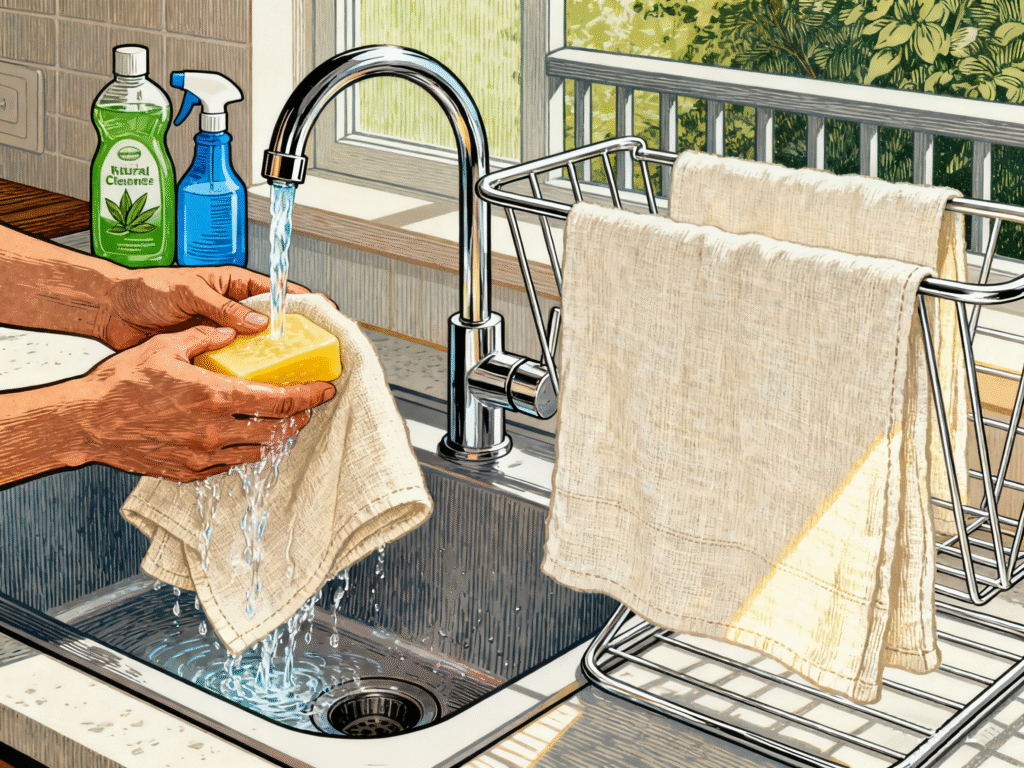
Linen may be a champion of multitasking, but here’s the catch: a towel that touches raw chicken one minute and polishes wine glasses the next can quickly become a bacterial Trojan horse. 🦠 That’s not drama—it’s exactly why agencies like the CDC, USDA, and FDA flag kitchen towels as one of the most common cross-contamination culprits in the home.
The Risk, Summarized
- Cross-contamination: Studies show harmful bacteria like E. coli and Salmonella can linger on damp towels for hours, sometimes days.
- Moisture + warmth = perfect incubator: Leaving a damp towel crumpled on the counter is basically an open invitation for microbial growth.
- Real-world consequences: A survey published in Food Protection Trends found that households that reused towels between tasks had a significantly higher rate of bacterial contamination.
Hygiene Rules Worth Following
- Wash often and hot: Run linen towels through the washing machine on a hot cycle (at least 60°C / 140°F) to kill bacteria effectively.
- Separate tasks: Dedicate one towel to drying dishes, another for hands, and another for produce. Never mix them up.
- No raw meat: Skip using towels altogether for blotting raw meat or fish—use disposable paper instead.
- Replace when soiled: If it looks dirty, smells damp, or has already been used for a risky task, swap it for a clean one immediately.
Color-Coding & Labeling Made Simple
Think of your kitchen like a restaurant line—organization reduces risk:
- Blue: For hands.
- White: For dishes.
- Green: For produce.
- Red: For hot pans and oven work.
Add small stitched icons (fork, leaf, droplet, flame) or tags to make sure even the groggiest morning cook doesn’t mix them up.
Quick Decision Tree: “Is This Towel Still Safe?”
Ask yourself four questions:
- Is it visibly soiled? → If yes, retire it.
- Is it damp? → If yes, wash or hang to dry fully before reuse.
- What was its last task? → Raw meat? Straight to the hamper.
- When was it last laundered? → If more than 1–2 days of heavy use, time for a wash.
Expert Insight
According to Dr. Mindy Brashears, former USDA Under Secretary for Food Safety: “Towels can act as a vehicle for pathogens if not washed frequently in hot water. Households should think of them like cutting boards—dedicated to tasks, cleaned often, and replaced when worn.”
Handled correctly, linen tea towels remain not only sustainable but also safe for everyday kitchen use. Now that hygiene is squared away, the next question is choosing the right towel for the right job.
👉 How to Choose the Right Linen Tea Towel — For Every Use
How to Choose the Right Linen Tea Towel — For Every Use
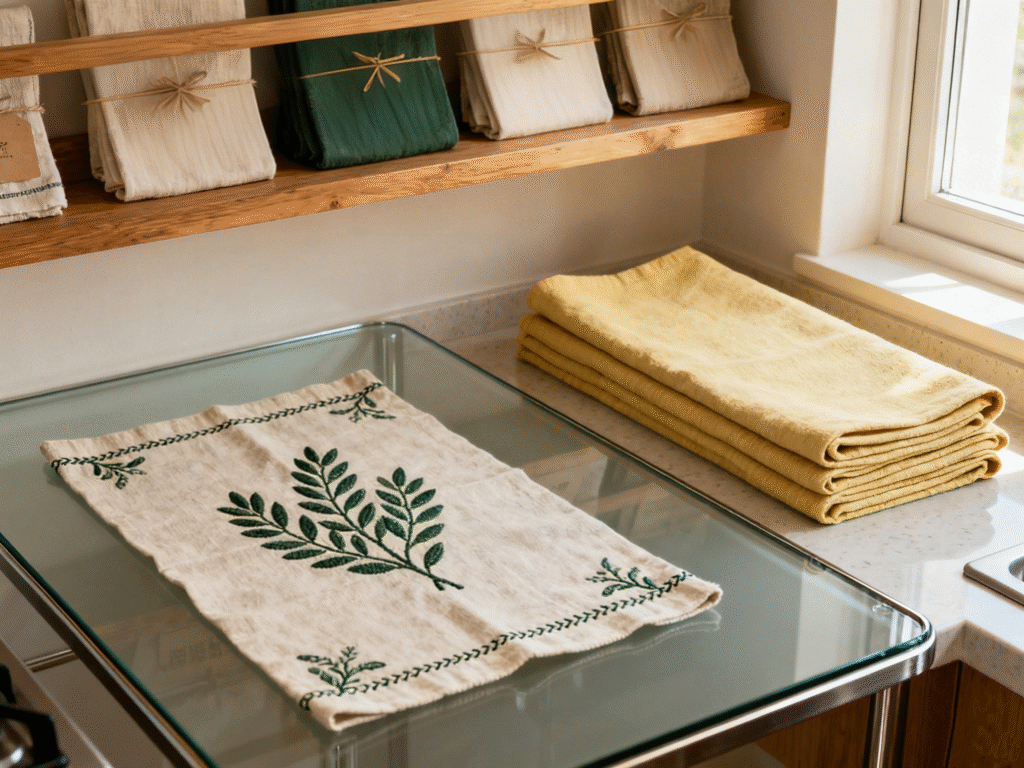
Now that you know how to keep your towels clean and safe, the fun part begins: choosing the right ones for your kitchen (and beyond). Linen tea towels may all look similar at first glance, but subtle differences in fabric, size, and finish can completely change how they perform. Pick carefully, and you’ll have a towel that works hard and looks good doing it.
Fabric Weight & Weave
- Thick linen: Denser weaves are highly absorbent and durable, making them ideal for heavy-duty tasks like drying dishes, proofing bread, or handling hot pans. They’ll last years if properly cared for.
- Lightweight linen: These towels dry quickly, fold neatly, and often look more refined. Perfect for table settings, gift wrapping, or as decorative kitchen accents. They won’t soak up gallons of water, but they will add elegance.
Size Considerations
- Standard (18 × 28 in.): The classic kitchen size—easy to hang, fold, or sling over your shoulder. Works for most day-to-day needs.
- Oversized towels: Versatile enough to double as bread wraps, picnic covers, or makeshift table runners. If you want one towel to handle cooking, serving, and styling, oversized is your best bet.
Colors & Patterns
- Neutral tones: Timeless, minimalist, and easy to match with any kitchen style. They also hide light stains better.
- Bold prints: Great for making a statement—stripes, florals, or modern geometric patterns can bring life to a plain counter.
- Seasonal motifs: Festive designs are perfect for gifting or rotating into your kitchen décor during holidays.
Finish & Softness
- Pre-washed linen: Already softened and slightly rumpled, ready for immediate use. These towels are practical for everyday tasks and easy to launder.
- Crisp linen: Starts out stiff but softens beautifully with washing. Often chosen for decorative or “guest” towels, they develop a lived-in charm over time.
Quick Checklist Before Buying
- ✅ Is the weave suited to your purpose (thick for absorbency, light for elegance)?
- ✅ Does the size match how you’ll use it (drying vs. styling)?
- ✅ Does the color or pattern fit your kitchen—or the person you’re gifting it to?
- ✅ Is it pre-washed for softness, or do you want it to age naturally?
- ✅ Are care instructions clear so you can maximize its lifespan?
Choosing wisely means your linen towels won’t just be useful—they’ll feel like a thoughtful part of your kitchen design. And once you’ve selected your perfect set, the real fun begins: finding clever, stylish ways to put them to work.
| Feature | Options | Best For | Pros |
|---|---|---|---|
| Fabric Weight & Weave | Thick linen | Drying dishes, proofing bread, handling hot pans | Highly absorbent, durable, long-lasting |
| Lightweight linen | Table settings, gift wrapping, decorative accents | Quick-drying, folds neatly, elegant look | |
| Size | Standard (18 × 28 in.) | Everyday kitchen use, easy storage | Classic size, versatile, easy to hang or fold |
| Oversized towels | Bread wraps, picnic covers, makeshift table runners | Multi-purpose, doubles as cooking + styling tool | |
| Colors & Patterns | Neutral tones | Minimalist kitchens, timeless décor | Easy to match, hides light stains |
| Bold prints | Modern kitchens, making a statement | Adds personality, wide variety of designs | |
| Seasonal motifs | Holiday décor, gifting | Festive, fun, great for rotating styles | |
| Finish & Softness | Pre-washed linen | Everyday use, easy laundering | Soft from the start, practical, slightly rumpled look |
| Crisp linen | Guest towels, decorative use | Develops charm over time, refined and classic appearance | |
| Buying Checklist | Key questions to ask | Purpose, size, style, softness, and care instructions | Ensures you choose the right towel for both function and design |
👉 How to Style and Use Linen Tea Towels — Practical and Decorative Ways
How to Style and Use Linen Tea Towels — Practical and Decorative Ways
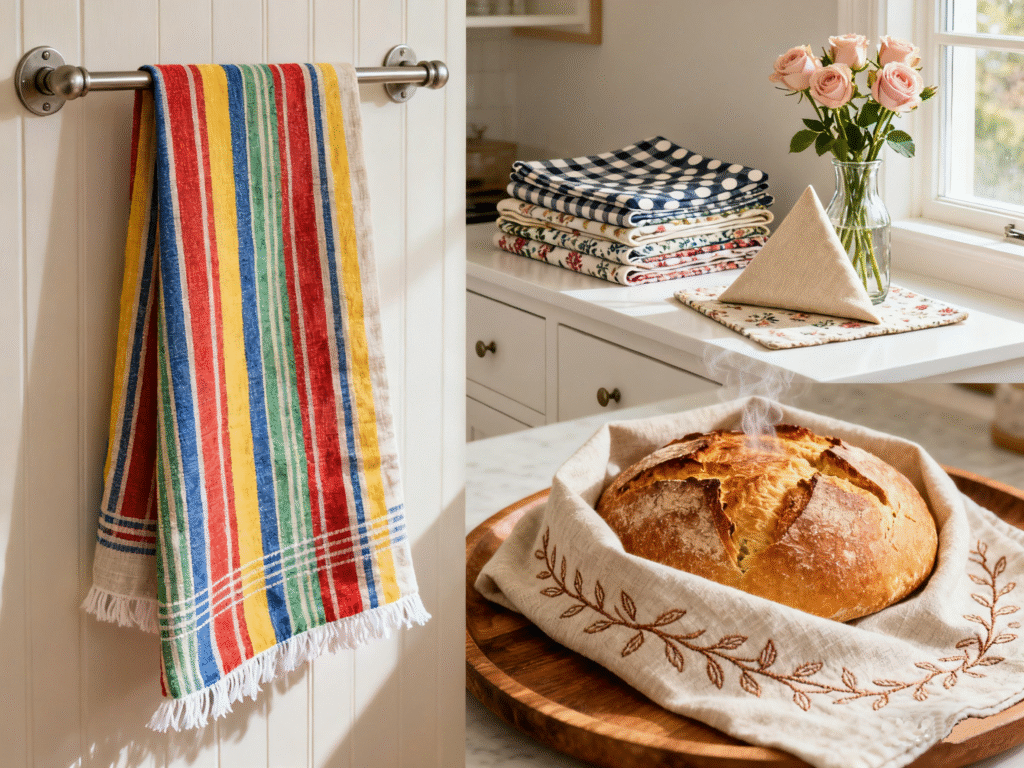
By now, you’ve chosen your ideal linen towels—now let’s put them to work in ways that are both practical and stylish. Whether you want to streamline your kitchen or elevate your home décor, linen tea towels adapt beautifully. Here are the most versatile uses, each backed by linen’s unique qualities:
- Drying dishes efficiently
Linen’s hollow fibers make it more absorbent than cotton while also quick-drying. That means fewer streaks, less lint, and towels that don’t stay damp for hours. - Wrapping fresh bread & produce
Linen is breathable, which helps bread crusts stay crisp while keeping the interior soft. It also works as a natural produce wrap, slowing wilting without trapping excess moisture. - Stylish napkins & placemats
Folded neatly, linen towels double as casual napkins or placemats—an affordable alternative to expensive table linens. They launder easily, so you can use them daily without worry. - Eco-friendly gift wrap
Inspired by Japanese furoshiki, tea towels make chic, reusable wrapping for wine bottles, cookbooks, or baskets. It’s a sustainable twist that turns the wrapping itself into part of the gift. - Protecting & polishing glassware
Professional sommeliers love linen because it’s lint-free and leaves glasses spotless. Use it to polish wine glasses or champagne flutes for a streak-free shine. - Décor accents
Hung casually over an oven handle, layered on a serving tray, or even framed as wall art, linen towels bring understated elegance to a space. With bold prints or seasonal designs, they double as rotating décor. - On-the-go uses
Keep a spare towel in your bag or car—it makes an instant picnic cloth, basket liner, or hand towel. Lightweight, quick-drying linen is perfect for life outside the kitchen.
📸 Tip: Use images or infographics to show each use—this not only improves engagement but also helps your content stand out in search results and featured snippets.
Linen tea towels prove that practicality and beauty can live side by side. From dish duty to décor, they’re small textiles with outsized potential. But if you want them to stay gorgeous and effective for years, the next step is knowing how to care for them properly.
👉 How to Care for Linen Tea Towels — Ensuring Longevity
How to Care for Linen Tea Towels — Ensuring Longevity
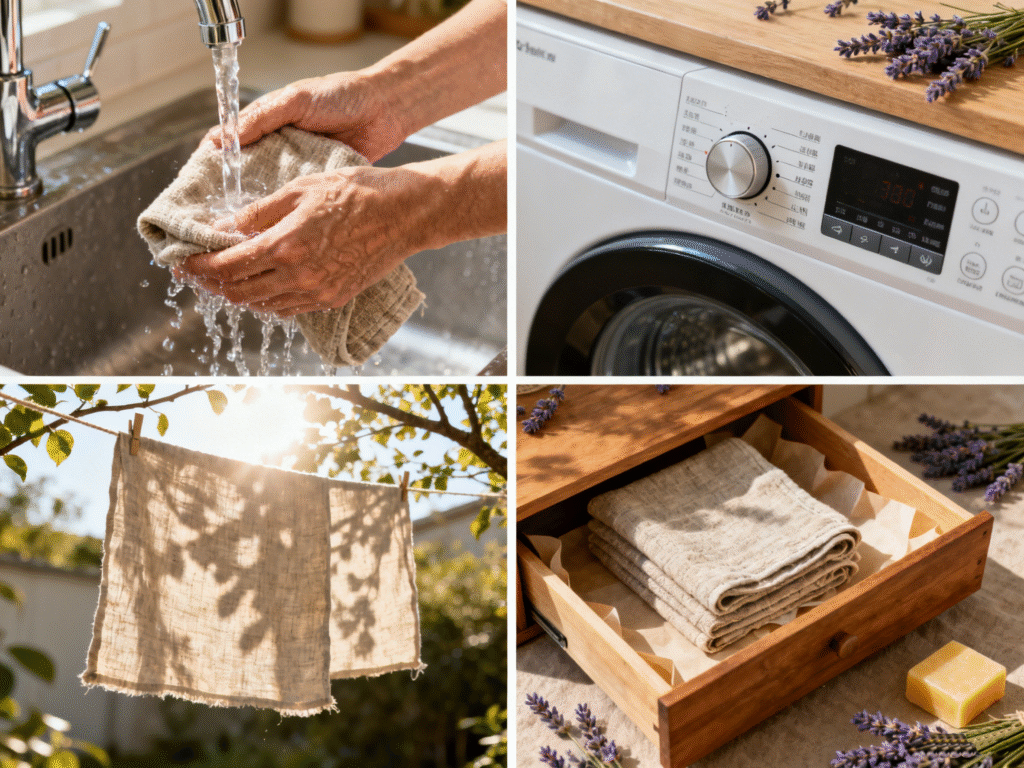
You’ve styled, used, and even polished with your linen tea towels—now it’s time to make sure they last. With the right care, linen doesn’t just maintain its beauty; it actually improves with age, becoming softer and more absorbent over time. Here’s how to treat your linens like the durable, elegant workhorses they are:
Washing Guidelines
- Temperature: Cold or lukewarm water is safest to prevent shrinking and color fading. Avoid boiling water unless you need to disinfect heavily soiled towels.
- Detergent: Use a gentle, fragrance-free detergent. Harsh chemicals, bleach, or fabric softeners can break down fibers over time.
- Tip: Wash linen towels separately or with similar colors to maintain vibrancy.
Drying Tips
- Air-dry: The gentlest option—hang towels flat or drape over a line to retain shape and prevent stiffness.
- Tumble dry on low: Use if you prefer softer, crisper towels. Avoid high heat, which can weaken fibers.
Ironing or Not?
- Natural wrinkles: Embrace them for a rustic, casual charm—perfect for kitchens with a cozy, lived-in feel.
- Pressed linen: Iron while slightly damp for a crisp, elegant look, ideal for table settings or decorative display.
Stain Removal Tips
- Baking soda paste: Effective for oil or food stains—apply, let sit, then rinse.
- Lemon or vinegar: Natural, safe acids that brighten whites and lift discoloration.
- Tip: Treat stains as soon as possible; the longer they set, the harder they are to remove.
Longevity Note
Linen grows softer and more absorbent over time—what starts crisp will evolve into a flexible, highly functional towel. Regular rotation, proper washing, and mindful handling will extend its lifespan for years, even decades.
Caring for your linens properly completes the circle of selecting, using, and styling them. With longevity handled, the next step is separating fact from fiction—understanding the myths and everyday truths about linen towels.
👉 What to Know About Linen Tea Towels — Myths and Everyday Uses
What to Know About Linen Tea Towels — Myths and Everyday Uses
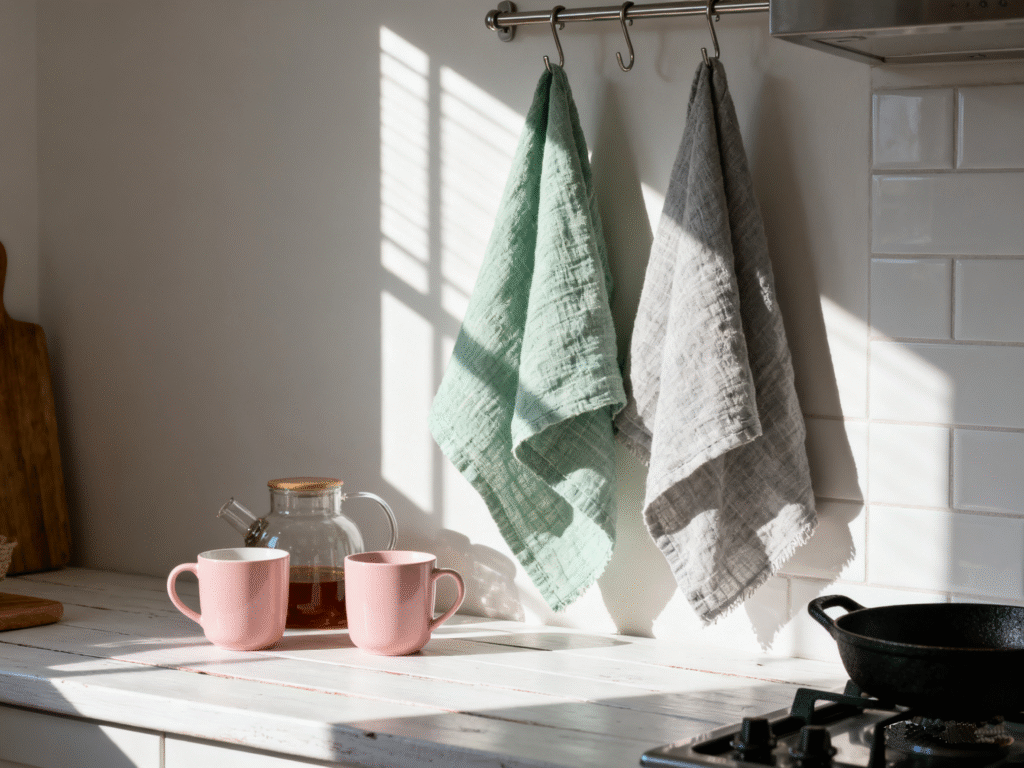
Even seasoned home cooks can fall for common misconceptions about linen tea towels. Separating fact from fiction helps you make the most of these versatile textiles while keeping your kitchen safe and stylish.
Myth 1: “Linen is naturally antimicrobial.”
Reality check: Evidence is mixed. While some studies suggest linen may inhibit certain bacteria under controlled conditions, untreated linen used in everyday kitchens shows no consistent antimicrobial effect. Don’t assume it can replace proper hygiene—regular laundering and task separation are still essential.
Myth 2: “One towel can do every job.”
Reality check: For safe, hygienic kitchens, this just isn’t true. Towels should be dedicated to specific tasks—hands, dishes, produce, or hot items—to prevent cross-contamination. Even the most absorbent towel cannot safely multitask without risk.
Myth 3: “Cold washes are always fine.”
Reality check: Cold water is gentle on linen fibers and colors, but it may not decontaminate towels that have been in contact with raw meat, dairy, or other high-risk foods. Use hot washes when appropriate to kill bacteria and keep towels safe for repeated use.
Understanding the realities of linen helps you appreciate its strengths while avoiding pitfalls. With myths clarified, you can now address a practical question every kitchen owner faces: how many towels are actually needed to stay clean, organized, and stylish.
👉 How Many Kitchen Towels Do You Really Need? — Related Reading
How Many Kitchen Towels Do You Really Need? — Related Reading
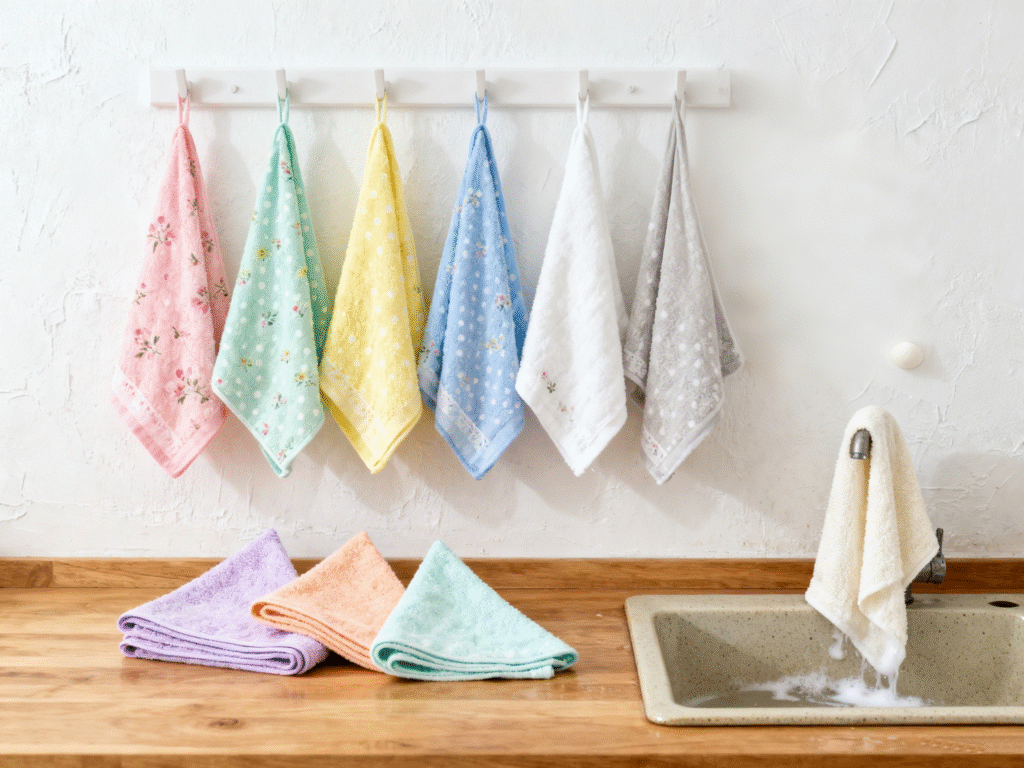
Even with the best care, style, and usage knowledge, many households struggle with one simple question: how many towels are enough? Too few, and you’re constantly running the laundry or reusing damp towels. Too many, and your kitchen becomes cluttered with linen you rarely use.
Finding the right balance is key to maximizing both hygiene and efficiency. A practical approach considers your cooking habits, household size, and preferred towel tasks (drying dishes, handling hot pans, polishing glassware, etc.).
For a complete breakdown, including starter kits, calculators, and expert-recommended quantities, check out our companion article: Ultimate Guide to Kitchen Towels: Quantity, Usage, and Expert Tips. Pairing that guidance with your knowledge of linen towel uses ensures you’re stocked, organized, and ready for any kitchen scenario.
By combining both articles, readers gain the full picture—how to use your towels effectively and how many you need to keep your kitchen running smoothly.
With usage and quantity covered, it’s time to explore another reason linen towels shine: their sustainability. Understanding their eco-friendly advantages reinforces why investing in quality linens is both smart and responsible.
👉 Why Linen Tea Towels Are Sustainable — Substantiating the Eco-Friendly Choice
Why Linen Tea Towels Are Sustainable — Substantiating the Eco-Friendly Choice
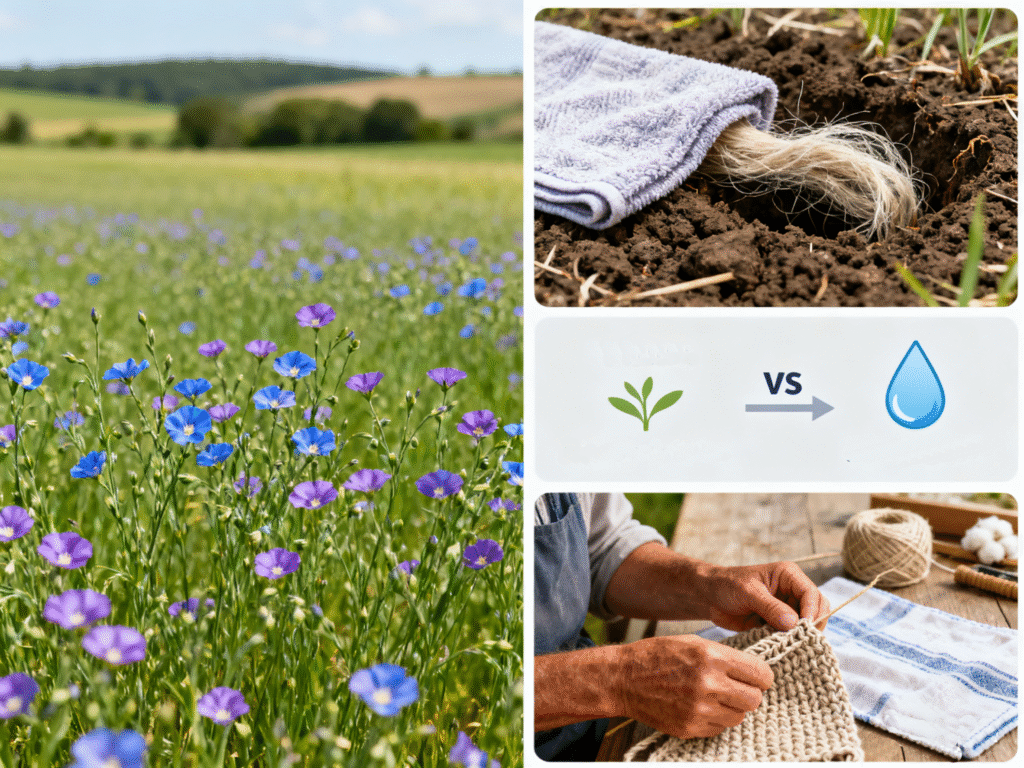
Linen isn’t just beautiful and versatile—it also holds notable eco-advantages when compared with other common textiles. But as with any material, the details matter. Let’s examine the evidence so you can make informed, responsible choices.
What the Life-Cycle Analyses Show
Peer-reviewed studies comparing flax (linen) to cotton reveal meaningful differences:
- Water usage: Flax generally requires less irrigation than conventional cotton, though regional rainfall and farming practices can shift the numbers significantly.
- Greenhouse gas emissions: Linen production tends to have lower GHG emissions per kilogram of fiber, partly because flax often grows without intensive synthetic fertilizers.
- Input efficiency: Flax requires fewer pesticides and fertilizers compared to cotton, though variability exists depending on soil, climate, and agricultural practices.
Key takeaway: While linen is generally more eco-friendly, local factors and cultivation methods matter. Blanket claims are misleading—look for certified or transparently sourced linens when possible.
Longevity Math
One of linen’s most significant sustainability advantages is durability. A high-quality linen tea towel can last 10–15 years with proper care, compared to disposable alternatives:
- Paper towels: Even a modest household may go through hundreds per year, generating considerable waste.
- Linen towels: Invest once, use repeatedly, and reduce both waste and recurring costs.
End-of-Life Considerations
- Composting: 100% undyed, untreated linen can be composted safely, returning nutrients to the soil.
- Trims & labels: Remove synthetic threads, labels, or decorative trims before composting to ensure a clean, eco-friendly breakdown.
Understanding linen’s sustainability adds another layer to its value—beyond style and utility, it’s a responsible choice for eco-conscious kitchens. And for those who appreciate quality, the discussion naturally leads to another aspect: everyday luxury.
👉 Why Linen Tea Towels Are an Everyday Luxury — For Kitchen and Home
Why Linen Tea Towels Are an Everyday Luxury — For Kitchen and Home
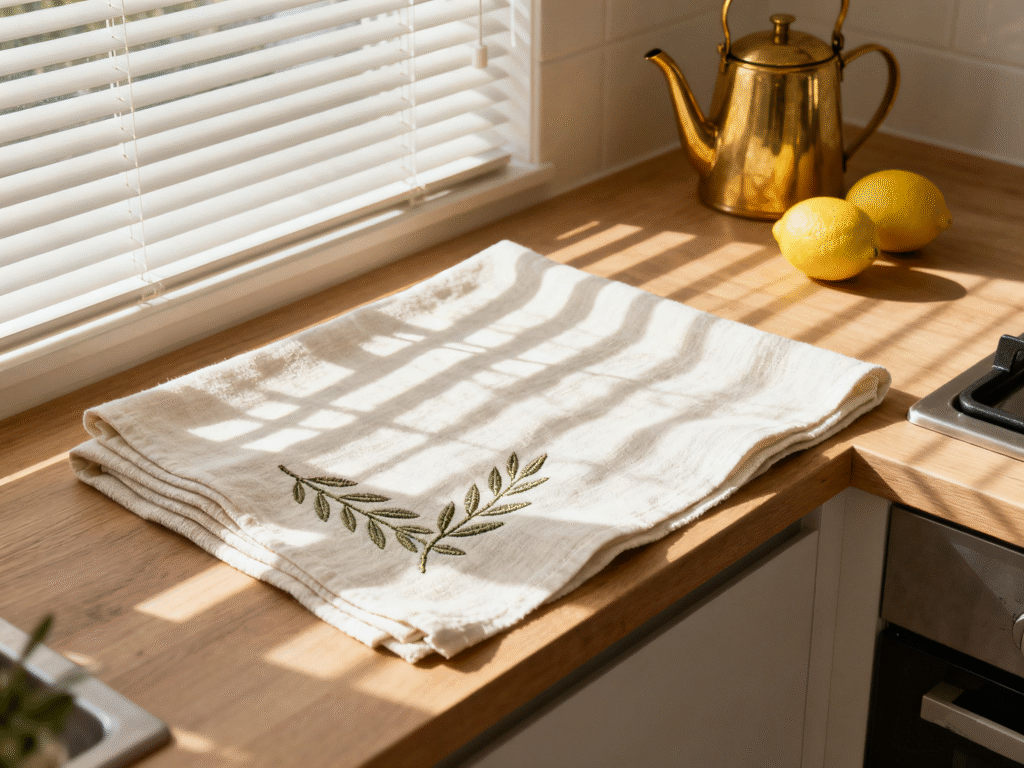
By now, it’s clear that linen tea towels are far more than simple kitchen tools. Their versatility, timeless beauty, and eco-friendly advantages combine to create a small but impactful upgrade for any home.
- Versatility: From drying dishes and proofing dough to serving as stylish napkins or gift wraps, linen tea towels adapt to countless tasks.
- Beauty: With their natural textures, elegant drape, and range of colors and patterns, they enhance both everyday kitchens and special occasions.
- Eco-benefits: Durable, reusable, and compostable, linen offers a responsible alternative to single-use paper or synthetic textiles.
Think of linen towels as a small switch with a big lifestyle impact. Introducing just one or two high-quality linen towels into your kitchen can transform daily chores into simple rituals of style and efficiency. It’s no wonder they have been beloved for centuries.
Call to action: Try incorporating one or two linen tea towels in your kitchen—you’ll quickly see why these humble linens continue to earn their place as both practical and elegant essentials.
With their utility, aesthetics, and sustainability addressed, it’s natural to anticipate the practical questions readers may have. From washing routines to replacing old towels, the next section tackles FAQs to provide clear, expert answers.
👉 FAQs — Common Questions About Linen Tea Towels
Tea towels are versatile kitchen textiles primarily designed for drying dishes, hands, and surfaces. Beyond drying, they serve multiple roles:
Food handling: Wrapping bread, covering dough, or storing produce.
Kitchen protection: Placing under cutting boards, bowls, or hot pans to prevent slips and heat damage.
Serving and styling: Acting as napkins, placemats, or decorative accents.
Cleaning: Polishing glassware, buffing stainless steel, or tidying up small spills.
Essentially, tea towels are both functional tools and decorative accessories for the kitchen.
Linen tea towels are prized for their absorbency, breathability, and durability. Common uses include:
Drying dishes: Their hollow fibers absorb water efficiently without leaving lint.
Covering dough or proofing bread: They wick moisture while preventing sticking.
Wrapping bread or produce: Breathable linen helps maintain freshness.
Polishing and protecting surfaces: Ideal for streak-free glass or stainless steel polishing.
Decorative or serving purposes: As table linens, gift wraps, or styling elements.
When using, ensure clean, task-specific towels to avoid cross-contamination, especially after handling raw foods.
Proper washing preserves both performance and longevity:
Temperature: Cold or lukewarm water for routine cleaning; hot water for towels that contact raw meat or high-risk foods.
Detergent: Use gentle, non-bleaching detergents. Avoid fabric softeners, which reduce absorbency.
Method: Machine wash or hand wash; avoid prolonged soaking.
Drying: Air dry for shape retention, or tumble dry on low for softness.
Ironing: Optional—linen can be left naturally wrinkled for a rustic look or pressed for a crisp, elegant finish.
Linen tea towels provide several advantages over other textiles:
Superior absorbency: Dries dishes and hands efficiently.
Durability: Strong fibers withstand repeated washing and heavy use.
Quick-drying: Reduces bacterial growth and mildew formation.
Eco-friendly: Long lifespan, reusable, and compostable if undyed.
Aesthetic appeal: Natural texture, soft patina with age, and versatile design for décor and gifting.
Yes. Linen’s hollow, porous fibers wick moisture rapidly, allowing towels to dry dishes, hands, and surfaces efficiently. They also dry quickly after laundering, reducing dampness that can harbor bacteria. For best results, fold loosely to allow airflow while drying.
The most effective cleaning approach combines temperature, detergent, and handling:
Sort by use: Separate towels used for raw foods from general cleaning towels.
Launder frequently: Daily or every 1–2 days for heavy-use towels.
Use hot or lukewarm water: Ensures proper decontamination while protecting fibers.
Gentle detergents: Avoid bleach or softeners that degrade fabric.
Dry completely: Hang or tumble dry on low to prevent mildew.
By following these steps, linen tea towels retain their absorbency, appearance, and hygiene, making them long-lasting kitchen essentials.



